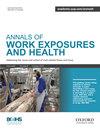153 无绳手持吸尘器性能测试
IF 1.8
4区 医学
Q3 PUBLIC, ENVIRONMENTAL & OCCUPATIONAL HEALTH
引用次数: 0
摘要
无绳手持式真空吸尘器市场正在迅速扩大,预计到 2027 年将达到 100 亿美元,这引起了人们对室内空气质量的关注。尽管需求不断增长,但对这些设备的气溶胶排放及其对呼吸系统健康的影响的研究却很有限,而这正是每个人目前都关心的问题。我们的研究旨在调查这些真空吸尘器的微粒物质(PM)排放情况,并找出造成这种排放的关键因素。我们设计了两个定制设备,用于量化上游和下游的可吸入颗粒物浓度,以及有无滤芯和电机排气时的吸力。我们在不同条件下测试了六种流行的无绳吸尘器型号,发现滤芯密封性、电机设计和灰尘负荷都会影响可吸入颗粒物的排放。与以往的研究不同,无刷电机(制造商声称)排放的颗粒并不一定比有刷电机少。我们还发现,有些滤芯不密封,会导致 PM 浓度显著上升,尤其是在重负荷条件下。虽然泄漏的滤芯会导致较高的吸力和洁净空气输送率,但由于 PM 排放量升高,我们仍然建议对气密性滤芯进行监管。我们的研究结果还表明,有必要对电机装配和设计标准进行监管,而不仅仅是电机类型。为了立即缓解这一问题,用户应通风并使用呼吸保护装置。我们的工作为了解吸尘器气溶胶排放对健康的危害奠定了基础,并为消费者的选择和潜在的监管措施提供了信息。本文章由计算机程序翻译,如有差异,请以英文原文为准。
153 Performance testing of cordless handheld vacuum cleaners
The cordless handheld vacuum cleaners market is expanding rapidly and is expected to reach $10 billion by 2027, raising concerns about indoor air quality. Despite growing demand, there is limited research into the aerosol emissions from these devices and their impact on respiratory health, which is a current concern for everyone. Our study aimed to investigate particulate matter (PM) emissions from these vacuum cleaners and identify the key factors contributing to such emissions. Two custom-built devices were designed to quantify upstream and downstream PM concentrations and suction pressure with and without filter cartridge and motor exhaust. We tested six popular cordless vacuum cleaner models under different conditions and found that filter cartridge sealing, motor design, and dust load can affect PM emissions. In contrast to previous research, brushless motors (manufacturer claims) do not necessarily emit fewer particles than brushed motors. We also found that some filter cartridges are not airtight and will cause PM concentration to rise significantly, especially under heavy load conditions. While leaking cartridges result in higher suction and clean air delivery rates, we still recommend regulating airtight filter cartridges due to elevated PM emissions. Our findings also suggest the need for regulations controlling motor assembly and design standards, not just motor type. For immediate mitigation, users should ventilate areas and use respiratory protection. Our work is a foundation for understanding the health risks of vacuum cleaner aerosol emissions and informs consumer choices and potential regulatory measures.
求助全文
通过发布文献求助,成功后即可免费获取论文全文。
去求助
来源期刊

Annals Of Work Exposures and Health
Medicine-Public Health, Environmental and Occupational Health
CiteScore
4.60
自引率
19.20%
发文量
79
期刊介绍:
About the Journal
Annals of Work Exposures and Health is dedicated to presenting advances in exposure science supporting the recognition, quantification, and control of exposures at work, and epidemiological studies on their effects on human health and well-being. A key question we apply to submission is, "Is this paper going to help readers better understand, quantify, and control conditions at work that adversely or positively affect health and well-being?"
We are interested in high quality scientific research addressing:
the quantification of work exposures, including chemical, biological, physical, biomechanical, and psychosocial, and the elements of work organization giving rise to such exposures;
the relationship between these exposures and the acute and chronic health consequences for those exposed and their families and communities;
populations at special risk of work-related exposures including women, under-represented minorities, immigrants, and other vulnerable groups such as temporary, contingent and informal sector workers;
the effectiveness of interventions addressing exposure and risk including production technologies, work process engineering, and personal protective systems;
policies and management approaches to reduce risk and improve health and well-being among workers, their families or communities;
methodologies and mechanisms that underlie the quantification and/or control of exposure and risk.
There is heavy pressure on space in the journal, and the above interests mean that we do not usually publish papers that simply report local conditions without generalizable results. We are also unlikely to publish reports on human health and well-being without information on the work exposure characteristics giving rise to the effects. We particularly welcome contributions from scientists based in, or addressing conditions in, developing economies that fall within the above scope.
 求助内容:
求助内容: 应助结果提醒方式:
应助结果提醒方式:


